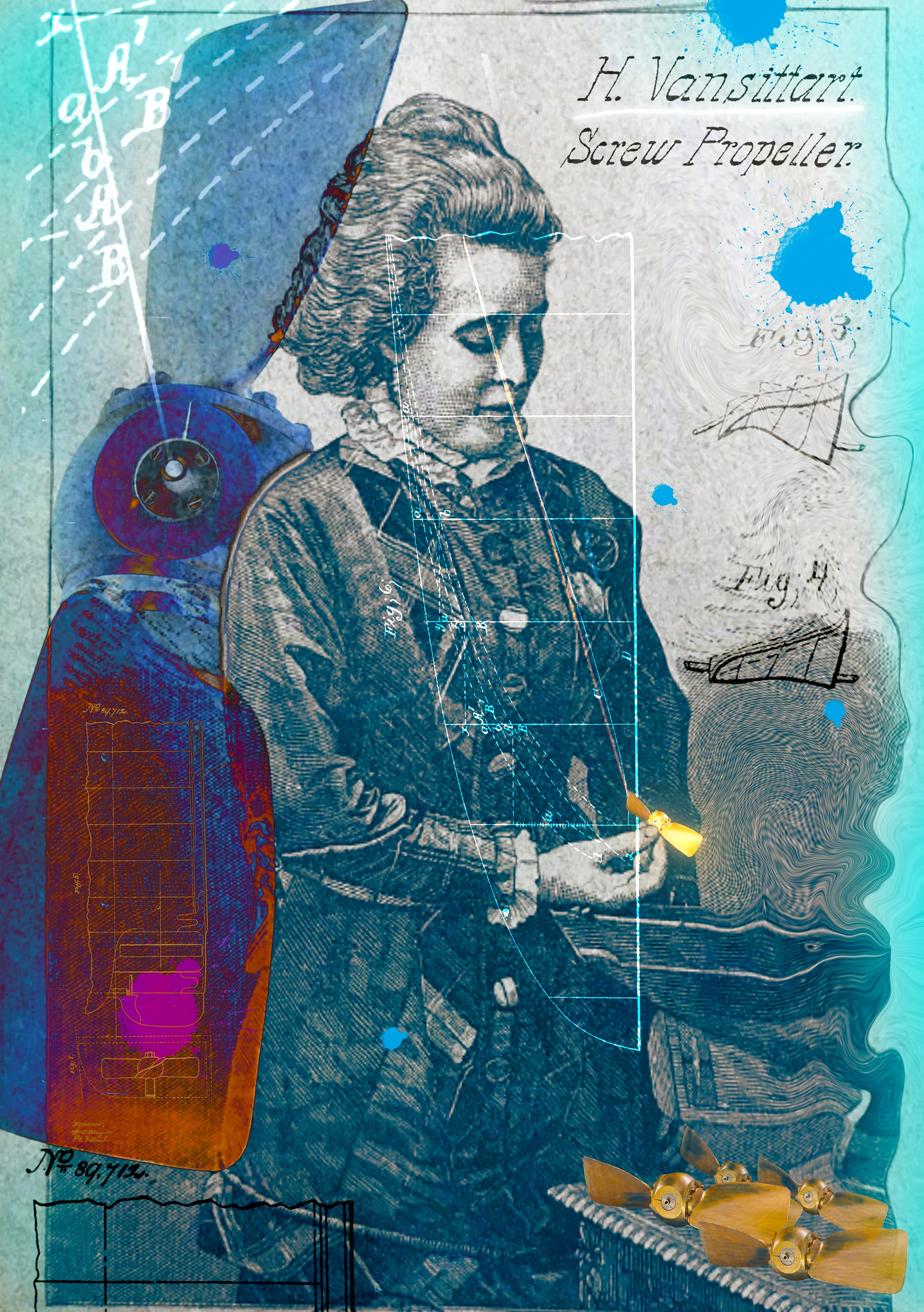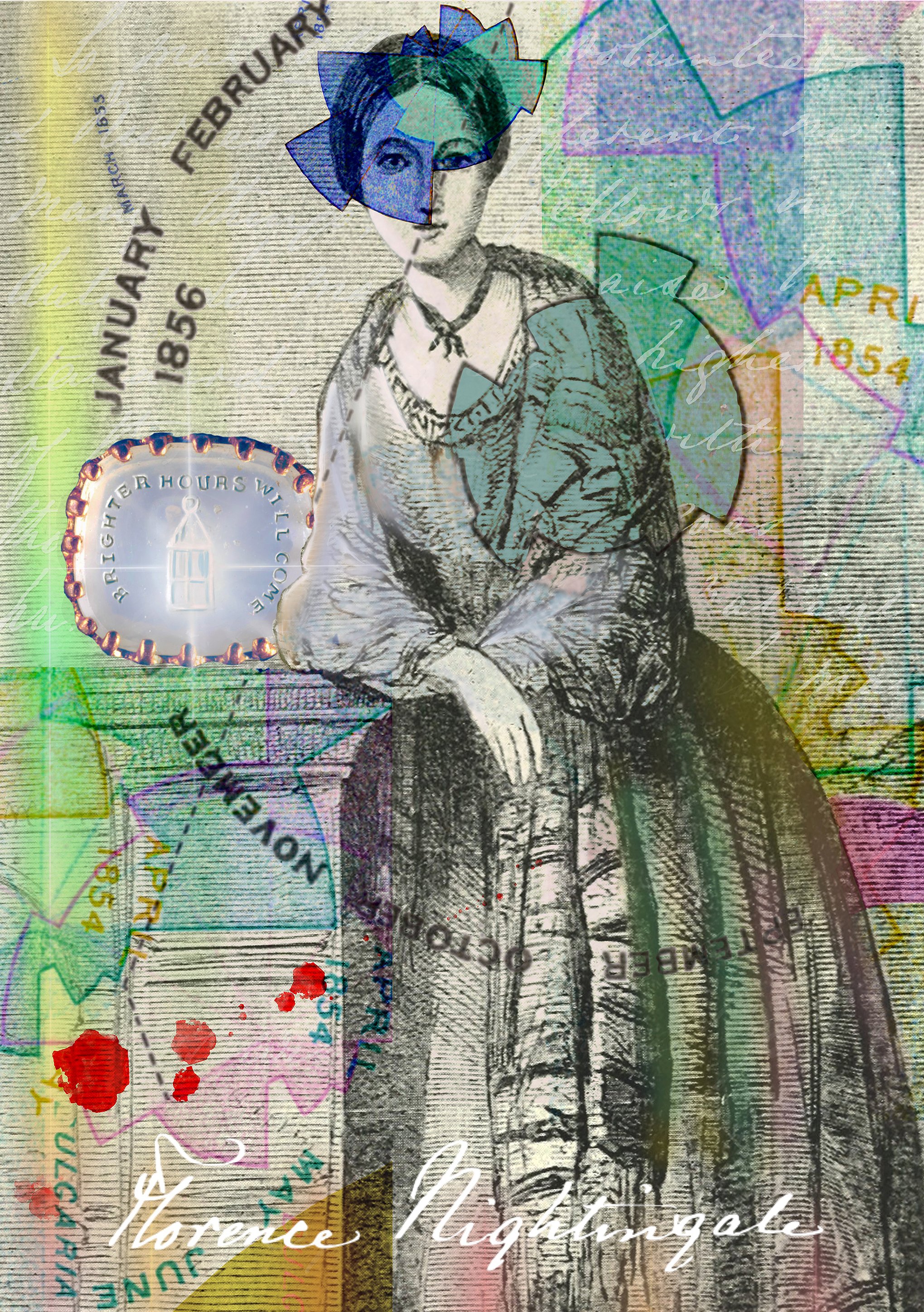scientific portraits : re-imagined
I love the aesthetic of hand-drawn technical and scientific imagery and I am interested in the pioneering female scientists who were overlooked in history, particularly in the 18th and 19th centuries. While womens’ stories are to some extent now surfacing alongside dominant male scientific history, their images often remain rooted in portraits from that period which rarely display their pioneering work and spirit.
So I am creating a series of re-imagined portraits of some of these women, surrounding and infusing them with their own drawings, handwritten observations, designs and legacies of their work, as well as personal objects. I wanted to bring them to life as active innovators, and to explore the way in which the original portraits could merge with contemporary colour and graphical style but still connect somehow to their time. I’m finding I’m drawn to the textures of etchings and drawings rather than early photography, where it exists. I’ve been tracking down archives that hold the source images and finding permissions - it’s taken me to some great online collections and I’ve been learning more about these women in the process. I hope these images honour and lift the original portraits.
The first series I’ve worked on are : Henrietta Vansittart, Caroline Herschel and Florence Nightingale.
Henrietta Vansittart (1833-1883) was a pioneering inventor and engineer who improved her father’s design of a screw propeller for steam ships.
Her re-imagined portrait is built from three main elements:
- the archive patent document with her drawings of the new screw propeller design
- a photo from the Science Museum Collection of a wooden model she made in 1869 © Science Museum Group.
- the original portrait of her from the front of a publication called The History of the Lowe Vansittart Propeller
There was something powerful about being able to connect her in this image with her development models that she used to keep around her house. I wanted to visually play with the size of the models and the scale of the final propellers that would have been fitted to ships. I like the way the large propeller appears to wrap around her, and the way the textures from her original image responded to digital warping to suggest flow and waves.
Unusually, next to the other women in this series, I think she commissioned the original portrait herself - so with more agency over it she seems to be holding a bit more interest and power for herself than other female scientists of a similar period. I still hope she might appreciate this re-imagining of her portrait..
Caroline Herschel was the first salaried female scientist on record and the first woman to hold a position in English government. She made independent astronomical discoveries including eight comets (1750 - 1848)
I shouldn’t really have a favourite, but as someone who studied physics and loves all kinds of music, I’ve always had a soft spot for Caroline Herschel as an astronomer and singer. Hers was the first portrait I worked on, as I really wanted to give her some power back after reading so often how a childhood typhus illness left her too short and ‘ugly’ to be married, and so she was destined to become a house servant.
I’ve created this image from an engraving of her as an older woman (remarkably for the time she lived to 97). I wanted to give the impression of creating a new window through which we can view her, animated with her cosmic discoveries. Her signature is from her musical notebooks, and her conducting diagram is depicted on her clothing. This notebook is from the Hanover Royal Music Archive. James Marshall and Marie-Louise Osborn Collection, Beinecke Rare Book and Manuscript Library, Yale University.
Her astronomy notebooks are represented with her handwritten note and diagram of the location of a comet. “I see and (sic) object like a star with a burr all around. But a very strong fogg prevents all farther observations. I hope to find the place again by the 4 stars here delineated.”
The background is subtly composed of a modern photographic image of her first discovery, star cluster NG2360, and landing at her fingertip is an image of her Comet C taken in 1908.
I’ve also illuminated her image a little from the light of her comet, and played with digital warping of her right arm, thinking about how many mirrors she would have polished and telescopes assembled to try to maximise incident light in astronomical observations and to avoid aberrations of the images.
Florence Nightingale (1820 - 1910) was the founder of modern nursing, a social reformer and statistician.
The popularised image of Nightingale in her bonnet with her famous lamp, attending to wounded and sick soldiers in field hospitals often loses the wider story of her as an early statistician, collecting and visualising data on causes of mortality in the British army to inform her pioneering nursing approach. Different parts of Nightingale’s ‘rose diagram’ surround her in this image, and I wanted to use the central design of the chart as a replacement icon over her head where we would normally see her bonnet - I like the way the shape is reminiscent of female headwear at this time, and here it represents her innovative thinking. I also wanted to go back to this drawing of young Florence made by her sister - to make the most of the textures and to re-imagine her image as a data pioneer before the male gaze shaped photographic images of her. Checking the public domain status of this image took me online to the US where it’s held in the UCLA libraries special collection.
Next to her, I have reunited her with one of her belongings - presented here in playful relative sizing - her moonstone seal held in the Science Museum Collection with the motif ‘Brighter Hours Will Come’ and her lamp in the centre of it. It feels good to reference her famous lamp in this object but position it amongst her charts and data. The seal also nods to her prolific letter writing - her signature is taken from the Wellcome collection archive of her many letters, which are also represented in her handwriting in the background of this portrait.
Moonstone seal photo © Science Museum Group.





